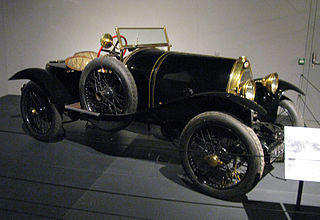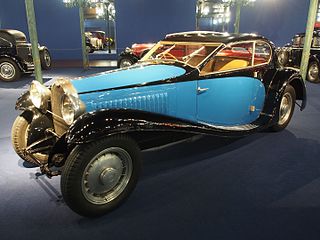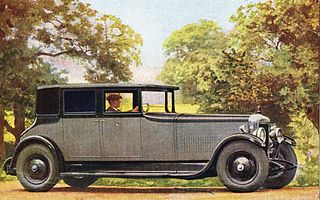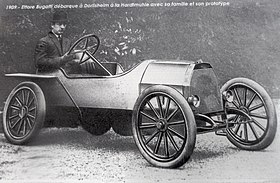
Automobiles Ettore Bugatti was a German then French manufacturer of high-performance automobiles. The company was founded in 1909 in the then-German city of Molsheim, Alsace, by the Italian-born industrial designer Ettore Bugatti. The cars were known for their design beauty and numerous race victories. Famous Bugatti automobiles include the Type 35 Grand Prix cars, the Type 41 "Royale", the Type 57 "Atlantic" and the Type 55 sports car.

Ettore Arco Isidoro Bugatti was an Italian-born French automobile designer and manufacturer. He received French citizenship in 1946. He is remembered as the founder and proprietor of the automobile manufacturing company Automobiles E. Bugatti, which he founded in 1909 in the then German town of Molsheim in the Alsace region of what is now France. Bugatti died in Paris, and is buried in Dorlisheim, France.

A multi-valve or multivalve engine is one where each cylinder has more than two valves. A multi-valve engine has better breathing, and with more smaller valves may be able to operate at higher revolutions per minute (RPM) than a two-valve engine, delivering more power.

The Lancia Fulvia is a car produced by Lancia between 1963 and 1976. Named after Via Fulvia, the Roman road leading from Tortona to Turin, it was introduced at the Geneva Motor Show in 1963 and manufactured in three variants: Berlina 4-door saloon, 2-door Coupé, and Sport, an alternative fastback coupé designed and built by Zagato on the Coupé floorpan.

The early Bugatti 8-cylinder line began with the 1922 Type 30. The same basic design was used for the 1926 Type 38 as well as the Type 40, Type 43, Type 44, and Type 49.

The Bugatti Type 57 and later variants was a grand tourer built from 1934 through 1940. It was an entirely new design created by Jean Bugatti, son of founder Ettore. A total of 710 Type 57s were produced.

The Lancia Rally was a mid-engine sports car and rally car built by Lancia in the early 1980s to compete in the FIA Group B World Rally Championship. Driven by Markku Alén, Attilio Bettega, and Walter Röhrl, the car won Lancia the manufacturers' world championship in the 1983 season. It was the last rear-wheel drive car to win the WRC.

The Bugatti Type 35 is an iconic race car design produced by Bugatti at their Molsheim premises between 1924 and 1930. It was extremely successful when raced by the factory works team. It was also bought by a diverse roster of privateer clientele from around the world. It pioneered the concept of a holistically conceived, race-ready car available for purchase.

The Bugatti Type 18, also called the Garros, is an automobile produced from 1912 through 1914. Produced shortly after the start of the business, the design was something of a relic. It had much in common with the cars Ettore Bugatti had designed for Deutz Gasmotoren Fabrik but with the radiator of the Type 13. Only seven examples were built, and three are known to survive.

The Bugatti Type 41, better known as the Royale, is a large luxury car built by Bugatti from 1927 to 1933, With a 4.3 m (169.3 in) wheelbase and 6.4 m (21 ft) overall length, it weighs approximately 3,175 kg (7,000 lb) and uses a 12.763 litre (778 cu in) straight-eight engine. For comparison, against the Rolls-Royce Phantom VII, the Royale is about 20% longer, and more than 25% heavier. This makes the Royale one of the largest cars in the world. Furthermore, with the limited production run and the premium nature of the vehicle, it is also both one of the rarest and most expensive.

The Bugatti Type 46 and later Type 50 were large enclosed touring cars and along with the Type 50B racing version, were all produced in the 1930s. Their relative ubiquity and numbers, combined with their styling caused them to sometimes receive the appellation of being a Molsheim Buick.

The Bugatti Type 32, commonly called the Tank de Tours, was a streamlined racing car built in 1923. It was built to compete in the French Grand Prix, which was held on July 2 in Tours on the same year.

The Bentley 3 Litre was a car chassis manufactured by Bentley. The company's first, it was developed from 1919 and made available to customers' coachbuilders from 1921 to 1929. The Bentley was very much larger than the 1368 cc Bugattis that dominated racing at the time, but double the size of engine and strength compensated for the extra weight. The 4000 lb (1800 kg) car won the 24 Hours of Le Mans in 1924, with drivers John Duff and Frank Clement, and again in 1927, this time in Super Sports form, with drivers S. C. H. "Sammy" Davis and Dudley Benjafield. Its weight, size, and speed prompted Ettore Bugatti to call it "the fastest lorry in the world", which was regarded as a compliment. Built in 3 main variants, Blue label, Red Label Speed models all carrying a 5-year warranty, and the coveted and rare Green Label 100 mph cars, which only carried a 12-month warranty reflecting the high state of tune.

The Bentley 4½ Litre is a British car based on a rolling chassis built by Bentley Motors. Walter Owen Bentley replaced the Bentley 3 Litre with a more powerful car by increasing its engine displacement to 4.4 litres. A racing variant was known as the Blower Bentley.

The Fiat 519 was a model of car produced by Italian automotive company, Fiat between 1922 and 1927.

The Ferrari 312 P was a Group 6 Prototype-Sports Car used for racing in 1969 and 1970. The new 1971 version of the sports prototype came with a flat-12 engine, often referred to as a boxer engine.

The Opel 4 PS, popularly known as the Laubfrosch (treefrog), is a small two-seater car introduced by the auto maker Opel early in 1924. Subsequently, various versions of the little Laubfrosch were produced until it was replaced by the Opel 1.2 litre.

The Hillman Fourteen is a medium-sized 4-cylinder car announced by Hillman's managing director Spencer Wilks, a son-in-law of William Hillman, at the end of September 1925. This new Fourteen substantially increased Hillman's market share and remained on sale into 1931. During this time it was the main product of the company.

The Daimler Double-Six sleeve-valve V12 was a piston engine manufactured by The Daimler Company Limited of Coventry, England between 1926 and 1938. It was offered in four different sizes for their flagship cars.
























